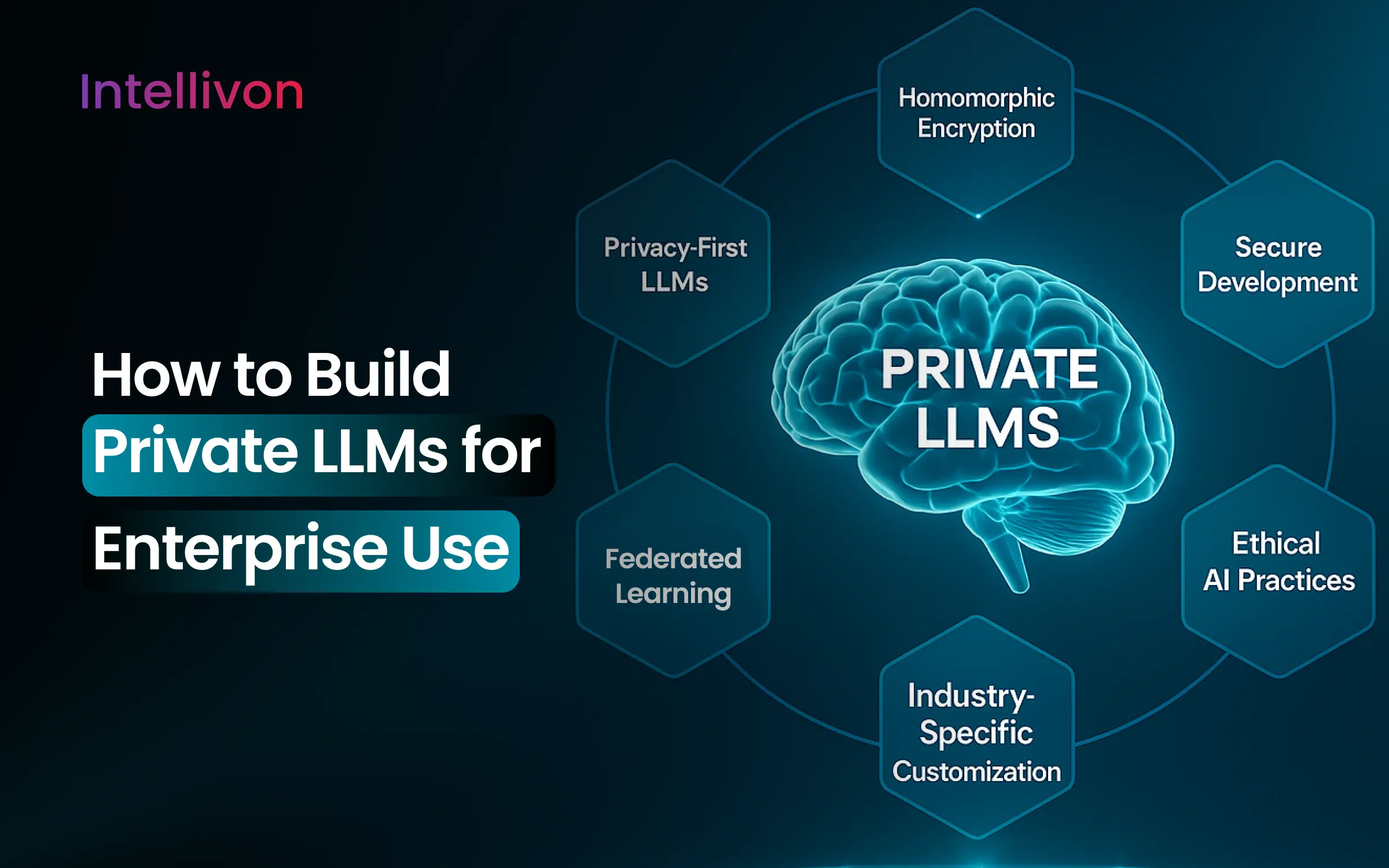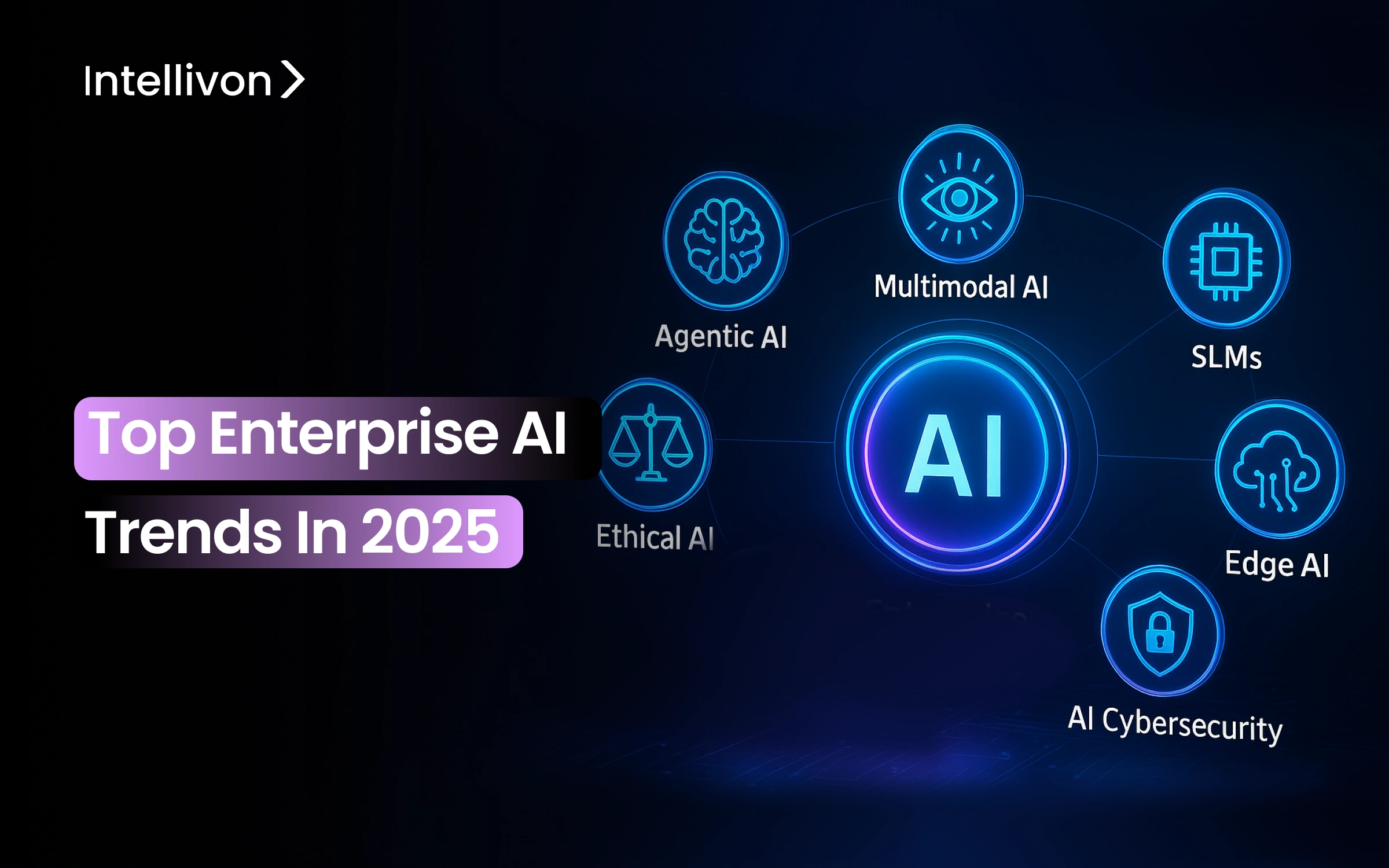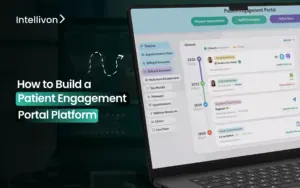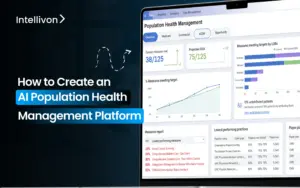In the current context, AI has moved beyond automating mundane tasks to include influence over the way enterprises think, decide, and compete. The most advanced organizations are moving past surface-level automation into intelligent systems that learn, adapt, and act with precision. This evolution is shifting workflows from reactive problem-solving to proactive strategy-making, giving leaders the power to anticipate opportunities and risks before they appear. For enterprise decision-makers, that means fewer blind spots, faster pivots, and strategies that outpace the market. Those who embed AI into the very fabric of their operations today will define the competitive benchmarks of tomorrow.
With AI adoption accelerating across data-driven industries, the urgency for quick, seamless, and scalable integration has never been higher. At Intellivon, we help enterprises design, build, and integrate AI solutions that align with their strategic goals from day one. In this blog, we’ll unpack the top Enterprise AI trends of 2025 and share how we can help you bring them to life in your workflows, effectively, securely, and at scale.
Key Market Takeaways for AI in Enterprise Operations
The enterprise AI market is expected to grow from USD 97.2 billion in 2025 to USD 229.3 billion by 2030, with an annual growth rate of 18.9%, according to a Mordor Intelligence report. The fuel behind this growth is attributed to the rapid adoption of generative AI, agentic systems that automate complex tasks, and increasing demand for specialized silicon to reduce inference times.
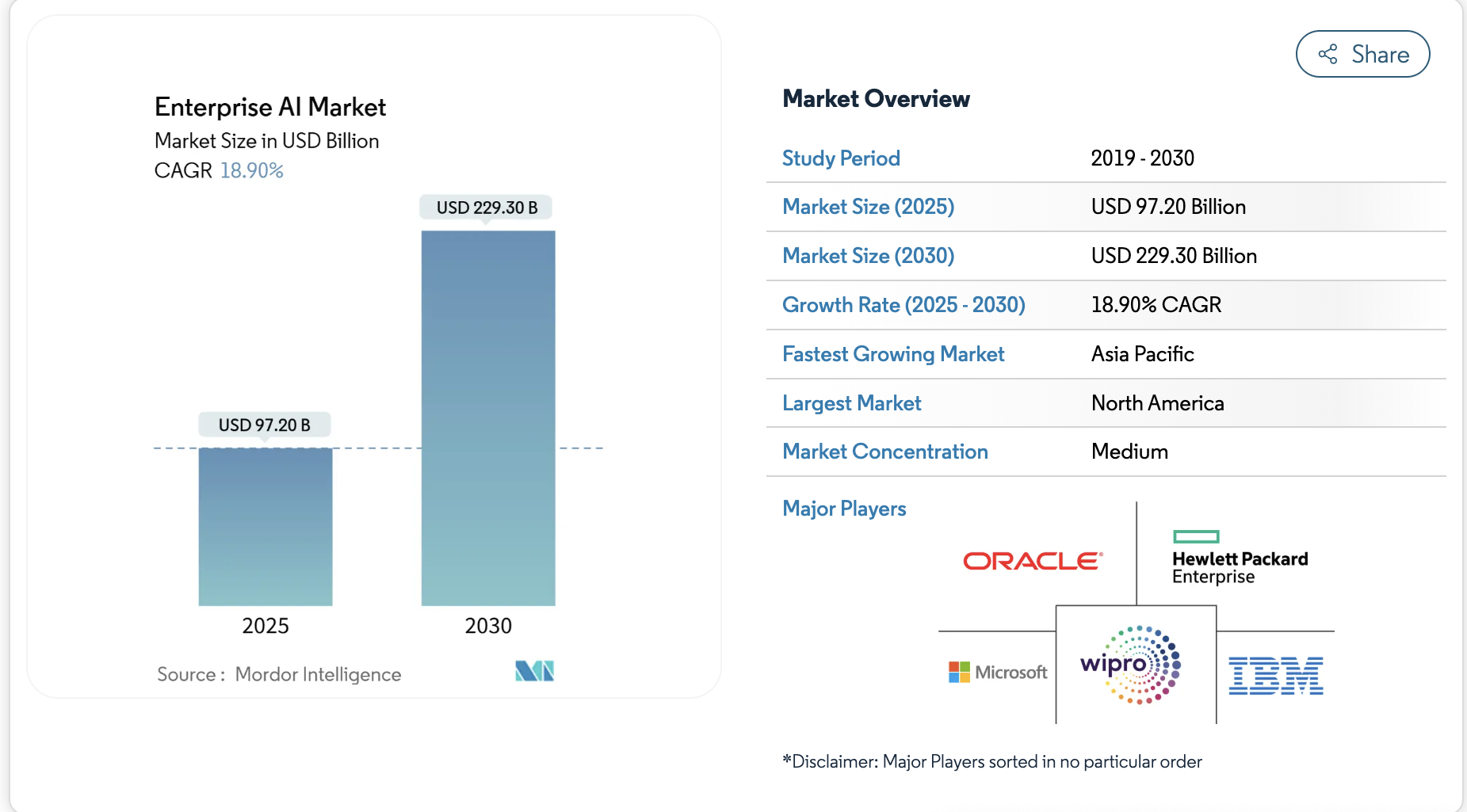
- The growing need for automation, AI-driven solutions, and the ability to process large enterprise data are major factors fueling this growth.
- Specialized hardware for AI, such as GPUs and TPUs, is also seeing rapid growth, with demand for AI chips expected to grow at over 23% annually.
- Hybrid and edge AI models are outpacing traditional public cloud deployments, as businesses prioritize lower latency and data sovereignty.
- Healthcare is leading AI investment, with a projected annual growth rate of 22.17%.
- AI is predicted to significantly boost global economic growth, with some estimates suggesting it could add more than $15 trillion in revenue by 2030 across various sectors.
Role of AI in Revolutionizing Enterprise Operations
AI has already become a core operational engine for enterprises across industries. It is transforming processes with unmatched efficiency, agility, and innovation. Here are some ways in which AI transforms enterprise operations.

1. Streamlining Operations Through Automation
AI-powered automation now handles both routine and complex workflows with minimal human input. From inventory management and compliance monitoring to customer service, AI systems process large datasets in real time, flagging issues instantly and making proactive adjustments.
This reduces manual work, cuts errors, and speeds up delivery. For example, leading retailers use AI to predict demand, optimize supply chains, and reduce costs, all while ensuring faster, more accurate deliveries. The result is smoother operations that scale without adding overhead.
2. Driving Data-Driven Decision-Making
Enterprises are harnessing AI analytics to turn vast amounts of structured and unstructured data into actionable insights. Predictive models powered by machine learning forecast market shifts, guide resource allocation, and refine product design.
These insights allow leaders to make faster, smarter decisions, keeping strategies aligned with real-time market intelligence. This agility translates directly into competitive advantage.
3. Enhancing Customer Experience and Personalization
AI is elevating customer service from reactive support to proactive engagement. AI chatbots and virtual assistants handle large volumes of queries instantly, providing tailored responses and freeing human agents to solve complex cases.
By analyzing behavior patterns, AI tools can recommend products, anticipate customer needs, and personalize offers, deepening loyalty and boosting retention.
4. Empowering Innovation with Gen AI
Generative AI is pushing enterprises beyond data analysis into content creation, code generation, and automated workflow design. Autonomous AI systems, combined with hybrid deployments that use both cloud and edge computing, ensure high speed, reliability, and security, which is critical for latency-sensitive operations like manufacturing or financial trading.
This opens new opportunities for innovation without increasing operational risk.
5. Ensuring Responsible AI and Governance
Enterprises are embedding governance frameworks to ensure fairness, transparency, and compliance with global regulations. Ethical AI practices not only reduce risk but also build trust with customers, investors, and partners. In a world where AI decisions shape business outcomes, governance is now a cornerstone of sustainable growth.
Top 15 Enterprise AI Trends in 2025
The AI landscape in 2025 is richer, faster, and more deeply integrated into enterprise operations than ever before. These 15 trends are shaping how global organizations innovate, compete, and grow. Each represents both an opportunity and a call to action for leaders ready to embrace change.
| Trend | What It Is | Enterprise Benefit |
| Agentic AI Systems | Autonomous AI agents that execute complex workflows with minimal human input. | Faster execution, reduced costs, and proactive operations. |
| AI-Augmented Workforce & Copilots | AI assistants that handle repetitive tasks and improve human-machine collaboration. | Higher productivity, faster decisions, and empowered employees. |
| AI-Driven Cybersecurity | Real-time threat detection and adaptive defense using AI. | Stronger security, reduced breach risk, and preserved trust. |
| Multimodal AI for Unified Insights | Integration of text, images, audio, video, and sensor data for richer insights. | Faster problem-solving and better operational resilience. |
| AI Governance & Ethical Frameworks | Policies ensuring transparency, fairness, and compliance in AI. | Reduced legal risk, improved trust, and stronger brand credibility. |
| Industry-Specific & Domain-Focused AI | Custom AI models designed for specific industries. | Higher ROI through targeted, relevant solutions. |
| Hyper-Personalization & Predictive AI | Real-time personalization and forecasting of customer needs. | Increased loyalty, retention, and revenue growth. |
| Small Language Models (SLMs) & Edge AI | AI models running locally or at network edges for faster, private processing. | Improved privacy, compliance, and real-time decision-making. |
| AI Reasoning, RAG & Advanced Problem-Solving | AI capable of logical reasoning and enhanced knowledge retrieval. | More accurate decisions in complex, high-stakes situations. |
| Model Context Protocol (MCP) | Open standard connecting AI securely to enterprise systems. | More relevant outputs and secure contextual workflows. |
| Sustainable AI | Energy-efficient AI systems and green data centers. | Lower costs, better ESG compliance, and enhanced reputation. |
| AI Lifecycle Automation & Continuous Integration | Automated AI model training, deployment, and updates. | Consistent performance, compliance, and reduced manual work. |
| Generative AI as a Commodity | Widely available generative tools customized with proprietary data. | Unique, competitive solutions that competitors can’t duplicate. |
| Internal Knowledge Mining & Enterprise Search | AI techniques for extracting insights from internal documents and data. | Faster decision-making and improved compliance. |
| AI + Other Emerging Technologies (IoT, 5G, Blockchain) | Combining AI with IoT, 5G, and blockchain for enhanced capabilities. | Real-time data processing, secure transactions, and new business models. |
1. Agentic AI Systems
Autonomous AI agents are stepping up to handle entire business workflows with minimal human intervention. These systems can analyze data, make decisions, and act, all in real time.
For enterprises, this means fewer bottlenecks, faster execution, and reduced operational costs. From automated contract processing to supply chain adjustments, agentic AI transforms reactive processes into proactive, intelligent systems.
2. AI-Augmented Workforce & Copilots
AI copilots are changing how employees work. They assist in repetitive tasks, streamline decision-making, and enhance human-machine collaboration.
For example, AI copilots in finance can instantly analyze spreadsheets, highlight anomalies, and suggest optimizations. This frees professionals to focus on strategy rather than manual data entry. The result is a more agile and empowered workforce.
3. AI-Driven Cybersecurity
Cyber threats are evolving faster than traditional defenses can handle. AI-powered cybersecurity systems offer real-time threat detection and adaptive defense mechanisms.
Using behavioral analytics, these tools can detect unusual activity before it becomes a breach. Enterprises gain an edge by responding instantly, protecting both brand reputation and customer trust.
4. Multimodal AI for Unified Insights
Business data now comes in many forms, such as text, images, audio, video, and sensor readings. Multimodal AI integrates these diverse data types to create richer, context-aware insights.
A manufacturer, for example, can combine production-line video feeds with sensor data and maintenance logs to predict equipment failures before they occur. This unified approach accelerates problem-solving and boosts operational resilience.
5. AI Governance & Ethical Frameworks
As AI use grows, so does the need for trust, fairness, and compliance. Governance frameworks ensure AI decisions are transparent, ethical, and aligned with regulations.
Enterprises that adopt strong AI governance protect themselves from legal risks while building credibility with customers and partners.
6. Industry-Specific & Domain-Focused AI Solutions
Generic AI models can only go so far. Enterprises are turning to custom AI solutions built for their industries, whether in finance, healthcare, manufacturing, or logistics.
Tailored models deliver higher ROI by addressing domain-specific challenges, such as fraud detection in banking or predictive maintenance in heavy industry. These specialized systems create a competitive edge through precision and relevance.
7. Hyper-Personalization & Predictive AI
Today’s customers expect tailored experiences. Hyper-personalization uses AI to customize products, services, and interactions in real time.
Predictive AI takes it further by anticipating needs before they arise. Retailers can suggest the right product at the right moment, while B2B companies can forecast client demands months in advance. This boosts loyalty and revenue simultaneously.
8. Small Language Models (SLMs) & Edge AI
Not all AI needs to run in the cloud. SLMs and edge AI process data locally, on devices or network edges, for faster responses and better privacy.
This is essential for regulated sectors like healthcare or defense, where sensitive data must stay on-site. Edge AI also powers IoT environments, enabling real-time decision-making without latency.
9. AI Reasoning and RAG
Next-generation AI models can now reason through problems, not just predict outcomes. Retrieval-Augmented Generation (RAG) brings in relevant knowledge from large datasets to improve accuracy.
Enterprises can use these tools for high-stakes decision-making, from legal contract reviews to complex engineering challenges. The result is faster, better-informed solutions.
10. Model Context Protocol (MCP)
MCP is a new open standard that lets AI models connect securely and dynamically with enterprise systems. It enables context-rich AI workflows without compromising data security.
For enterprises, MCP means AI can pull the exact data it needs, from ERP systems to CRMs, in real time, delivering more accurate and relevant outputs.
11. Sustainable AI
Energy-efficient AI is moving from niche to necessity. Enterprises are adopting architectures and practices that lower carbon footprints while meeting environmental targets.
Green AI initiatives, such as using renewable-powered data centers, not only cut costs but also strengthen ESG compliance and brand reputation.
12. AI Lifecycle Automation & Continuous Integration
Managing AI at scale requires running it efficiently over time. AI lifecycle automation platforms streamline training, testing, deployment, and updates.
With continuous integration, enterprises can keep models accurate, compliant, and high-performing without manual intervention. This ensures long-term ROI from AI investments.
13. Generative AI as a Commodity
Generative AI tools are now widely available. But the real advantage lies in customization, which is fine-tuning models with proprietary enterprise data.
This allows organizations to create unique solutions that competitors can’t replicate, whether for marketing, product design, or internal knowledge generation.
14. Internal Knowledge Mining
Enterprises are unlocking the value hidden in their own archives. Advanced AI techniques like vector search and RAG make it possible to mine internal documents, emails, and logs for insights.
This not only speeds up decision-making but also supports compliance by making historical records instantly searchable.
15. AI + Other Emerging Technologies
AI becomes even more powerful when paired with other cutting-edge technologies. In IoT networks, it can process sensor data in real time. With 5G, it enables instant connectivity for mission-critical applications. Blockchain integration ensures secure, verifiable transactions in automated systems.
For enterprises, this synergy opens the door to entirely new business models and revenue streams.
Key 2025 Enterprise Trends Where AI Combines with Other Technologies
AI is no longer treated as a standalone technology in enterprise operations. Instead, they are integrating it with other advanced and emerging technologies to amplify its potential, creating powerful combinations that transform operations, improve customer experiences, and accelerate innovation.

1. AI + Cloud Platforms
AI and cloud computing have become inseparable in enterprise strategies. The cloud provides the scalability, flexibility, and global reach that AI needs to function at full capacity. This combination allows organizations to deploy AI-powered applications anywhere, while handling massive workloads in real time. For example, businesses are using AI in the cloud to predict demand, automate customer service processes, and manage complex supply chains without investing heavily in on-premises infrastructure.
Benefit: Scalable, cost-efficient AI deployment across global operations without heavy infrastructure investment.
Enterprise Application: A global retail chain uses AI in the cloud to synchronize inventory data across regions, ensuring faster restocking and optimized supply chains.
2. AI + Edge Computing
While the cloud enables scale, edge computing ensures speed and responsiveness. By running AI models directly on devices such as factory sensors, autonomous vehicles, and connected cameras, enterprises can process data instantly without depending on centralized servers. This is especially valuable in industries like manufacturing, healthcare, and logistics, where every millisecond counts.
Benefit: Enables immediate decision-making, reduced latency, and improved data privacy.
Enterprise Application: A manufacturing plant uses edge AI to detect equipment anomalies in real time, triggering instant shutdowns before costly failures occur.
3. AI + Multimodal Data Integration
Modern AI systems are no longer limited to a single data type. They can now process and integrate text, images, audio, video, and sensor data into unified insights. This multimodal capability allows businesses to understand their operations and customers in far greater depth.
Benefit: Creates a 360-degree operational and customer view for better decision-making.
Enterprise Application: A customer service platform analyzes chat transcripts, call tone, and submitted images to resolve issues faster and more accurately.
4. AI + Generative Technologies
Generative AI is evolving into a practical enterprise tool for accelerating creativity and reducing development cycles. When paired with design and engineering platforms, it can produce product concepts, marketing campaigns, and even functional software code in a fraction of the usual time.
Benefit: Accelerates innovation cycles while reducing production and design costs.
Enterprise Application: A consumer electronics company uses generative AI to design prototypes and create marketing visuals ahead of a product launch.
5. AI + Industry-Specific Technologies
AI delivers even greater value when integrated with technologies built for specific industries. For example, in finance and healthcare, pairing AI with regulatory compliance systems enables automated audits and faster detection of anomalies.
Benefit: Delivers tailored, high-ROI solutions that meet industry-specific needs.
Enterprise Application: A healthcare provider integrates AI with its patient management system to predict treatment outcomes while ensuring HIPAA compliance.
6. AI + Supercloud and High-Performance Hardware
Some AI applications, such as real-time video analytics or large-scale scientific simulations, require massive computing power. Enterprises are turning to supercloud environments powered by advanced GPUs, such as NVIDIA’s HGX H100, to handle these workloads.
Benefit: Unlocks high-intensity AI capabilities without compromising performance or scalability.
Enterprise Application: A research institution uses supercloud AI infrastructure to process terabytes of genomic data in hours instead of weeks.
7. AI + IoT and 5G Networks
The combination of AI, IoT, and 5G connectivity is enabling a new era of intelligent, connected operations. Enterprises can now monitor assets in real time, predict maintenance needs, and optimize performance across vast networks of devices.
Benefit: Improves operational efficiency, reduces downtime, and enables smart automation.
Enterprise Application: A logistics company uses AI-enabled IoT sensors and 5G to track shipments and dynamically reroute deliveries in response to traffic conditions.
8. AI + Explainable AI (XAI) and Governance Platforms
As AI systems take on more decision-making responsibilities, transparency and accountability are becoming critical. Explainable AI (XAI) allows organizations to understand why an AI made a specific decision, making it easier to audit outcomes, detect bias, and comply with regulations.
Benefit: Builds trust, ensures compliance, and reduces bias in AI decision-making.
Enterprise Application: A financial institution uses XAI tools to explain automated credit approval decisions, satisfying regulatory audits and improving customer trust.
Enterprise AI Use Cases in Action
In this section, we’ll explore each trend in depth, showing how it works, what it delivers, and how leading enterprises are already benefiting. Alongside detailed use cases, you’ll find real-world examples that bring each trend to life, proving why now is the time to integrate them into your strategy.
1. Agentic AI Systems
AI agents that operate independently are unlocking new levels of operational speed and accuracy. These systems can handle end-to-end workflows, from gathering data to making decisions, without constant human oversight.
Benefit: Automates complex business workflows end-to-end with minimal human intervention, freeing employees for higher-value strategic work.
Use Cases:
- Finance Process Automation: Agentic AI can process invoices from multiple formats, validate them against purchase orders, detect anomalies (e.g., duplicate or inflated amounts), and automatically initiate payment approvals. This eliminates multi-day processing delays.
- Autonomous Vendor Management: AI agents can independently source vendors, run cost-benefit analyses, negotiate contracts via email/chat, and draft agreements for legal review. This dramatically accelerates procurement cycles.
- Cross-System Incident Remediation: When a service-level agreement breach is detected (e.g., delayed shipment), the AI can coordinate across CRM, ERP, and logistics platforms to resolve the issue, update stakeholders, and re-route shipments without waiting for human input.
Real-World Example:
Omega Healthcare implemented UiPath’s AI-powered document understanding and process automation to handle massive volumes of billing and claims work in healthcare. These agentic systems extracted key details from forms, validated them, and executed the next steps automatically. As a result, the company saved thousands of employee hours monthly, improved claim accuracy, and reduced turnaround times from days to hours.
2. AI-Augmented Workforce & Copilots
AI copilots are redefining teamwork between humans and machines. They serve as digital assistants, removing repetitive work and enhancing strategic decision-making across every department.
Benefit: Enhances human productivity by providing real-time assistance, intelligent suggestions, and process acceleration.
Use Cases:
- Document & Email Summarization: Copilots can read through lengthy reports, summarize key findings, and draft response emails, allowing executives to process 3x the usual document load.
- Developer Productivity: AI coding assistants help engineers by generating boilerplate code, suggesting bug fixes, and explaining complex code blocks, cutting time spent on routine development by up to 40%.
- CRM-Embedded Sales Assistants: Copilots embedded into CRM systems suggest upsell opportunities, generate personalized pitches, and automatically update records after calls.
Real-World Example:
KPMG adopted Microsoft 365 Copilot to streamline HR and client delivery workflows. Employees reported significant time savings, multi-hour reductions in weekly administrative work, while improving document accuracy and turnaround. This has freed up consultants to focus on advisory services rather than repetitive tasks.
3. AI-Driven Cybersecurity
Cyber threats evolve daily, and AI is the only way to keep up. AI-powered defense systems predict, detect, and neutralize risks in real time, often before an attack even begins.
Benefit: Detects and neutralizes threats in real time, reducing breach risks and incident response times.
Use Cases:
- Proactive Threat Detection: AI models analyze millions of daily signals to flag zero-day exploits and advanced persistent threats before they spread.
- Insider Risk Detection: Behavioral analytics detect unusual login times, large-scale file downloads, or abnormal system access, alerting security teams instantly.
- Automated Incident Response: When malware is detected, AI can isolate compromised endpoints, revoke credentials, and start forensic logging, all in seconds.
Real-World Example:
CrowdStrike Falcon uses behavioral AI and massive telemetry to detect attacks that bypass traditional signature-based defenses. Enterprises use it to protect endpoints, cloud workloads, and identities. This has allowed companies to cut detection time from days to minutes, reducing breach damage and costs.
4. Multimodal AI for Unified Insights
Data doesn’t come in one format, and AI now understands them all. Multimodal models combine text, images, audio, video, and sensor data to give businesses a more complete, actionable view.
Benefit: Integrates multiple data types, like text, images, audio, video, and sensor data, into a single analytical view, enabling richer decision-making.
Use Cases:
- Customer Experience Analysis: AI can combine call center transcripts, facial expression recognition from video calls, and purchase history to understand customer satisfaction and predict churn risk.
- Manufacturing Quality Control: Multimodal AI can process live sensor data and visual inspections from production lines to detect defects in real time, reducing wastage.
- Healthcare Diagnostics: AI can analyze patient scans, voice notes from doctors, and electronic health records simultaneously to improve diagnostic accuracy.
Real-World Example:
Siemens Healthineers uses multimodal AI to merge imaging data, lab results, and patient history into a single dashboard for clinicians. This helps doctors make faster, more informed decisions, reducing diagnostic errors and improving patient outcomes.
5. AI Governance & Ethical Frameworks
Trust in AI is built on transparency and accountability. Governance frameworks ensure AI decisions are fair, compliant, and explainable, critical for regulated industries.
Benefit: Ensures AI systems remain transparent, fair, compliant, and trustworthy, reducing regulatory and reputational risks.
Use Cases:
- Bias Auditing: Automated bias detection in HR recruitment algorithms ensures hiring processes remain fair and legally defensible.
- Regulatory Compliance Tracking: AI can monitor changes in laws (e.g., GDPR, HIPAA) and alert legal teams about required model updates.
- Explainable Decision-Making: Explainable AI (XAI) tools allow enterprises to justify algorithmic decisions in finance, healthcare, and legal scenarios.
Real-World Example:
IBM’s Watson OpenScale enables enterprises to detect bias, track drift, and explain AI decisions. A leading European bank uses it to ensure compliance in loan approvals, reducing the risk of discriminatory lending practices and avoiding costly legal disputes.
6. Industry-Specific & Domain-Focused AI Solutions
One-size-fits-all AI rarely delivers optimal results. Tailored AI models designed for specific industries like finance, healthcare, and manufacturing unlock greater efficiency and ROI.
Benefit: Delivers tailored AI models optimized for the unique challenges and ROI potential of specific industries.
Use Cases:
- Healthcare: AI predicts patient readmission risks and optimizes care plans to improve outcomes and reduce costs.
- Finance: AI models detect fraud in high-volume transactions with greater accuracy than traditional rules-based systems.
- Manufacturing: Predictive maintenance AI forecasts equipment failures and schedules repairs before costly breakdowns occur.
Real-World Example:
John Deere utilizes domain-specific AI for precision agriculture, integrating weather data, soil analysis, and machine performance to optimize planting and harvesting. This has improved yields while reducing input costs.
7. Hyper-Personalization & Predictive AI
Customers expect businesses to anticipate their needs, and AI makes it possible. Predictive analytics and personalization engines create experiences that feel one-to-one, at scale.
Benefit: Delivers highly tailored customer experiences and accurate business forecasts.
Use Cases:
- Retail Personalization: AI recommends products based on purchase history, browsing behavior, and seasonal trends.
- Demand Forecasting: Predictive AI models optimize inventory by forecasting spikes or drops in demand across regions.
- B2B Account Management: AI anticipates client needs, suggesting proactive engagement strategies that increase retention.
Real-World Example:
Starbucks’ Deep Brew AI personalizes offers in its mobile app, adjusting to customer preferences and location. This has increased average order value and customer loyalty scores.
8. Small Language Models (SLMs) & Edge AI
Not all AI needs the cloud. Lightweight, privacy-first AI models run locally on devices or at the network edge, delivering instant results with minimal latency.
Benefit: Brings AI capabilities directly to devices or local networks, enabling faster processing and better privacy.
Use Cases:
- On-Device Document Summarization: Edge AI allows executives to process confidential documents without uploading them to the cloud.
- Smart Manufacturing Sensors: Local AI models analyze machine vibrations in real time to detect early failure signs.
- Healthcare Wearables: AI processes biometric data locally, alerting users and doctors to anomalies instantly.
Real-World Example:
Apple’s Neural Engine runs small AI models directly on devices for tasks like voice recognition and predictive text, safeguarding user data while maintaining speed and responsiveness.
9. AI Reasoning, RAG & Advanced Problem-Solving
AI is evolving beyond pattern recognition into real reasoning. Retrieval-Augmented Generation (RAG) and advanced logic enable AI to solve complex problems with higher accuracy.
Benefit: Extends AI’s ability to handle complex reasoning, multi-step problem solving, and deep knowledge retrieval.
Use Cases:
- Contract Analysis: AI uses Retrieval-Augmented Generation (RAG) to answer legal questions by pulling data from thousands of internal documents.
- Medical Research: AI retrieves relevant studies and reasons through findings to recommend new treatment paths.
- Strategic Planning: AI can merge historical data, competitive intelligence, and market projections to support long-term business decisions.
Real-World Example:
Thomson Reuters uses AI with RAG to provide lawyers with quick, accurate answers by pulling from its vast legal database, reducing research time from hours to minutes.
10. Model Context Protocol (MCP)
Seamless AI integration starts with secure connections. MCP enables AI to dynamically access enterprise systems and data while maintaining strict compliance controls.
Benefit: Establishes a secure, standardized way for AI models to dynamically connect with enterprise systems, enabling contextual and real-time AI workflows.
Use Cases:
- Dynamic Data Access: AI assistants can securely retrieve up-to-date information from ERP, CRM, and analytics systems without manual data exports.
- Context-Aware Automation: AI can adapt responses based on the specific department, client, or workflow it’s serving.
- Cross-System Collaboration: Multiple AI models can securely exchange data, enabling complex multi-department workflows such as order-to-cash automation.
Real-World Example:
Salesforce Einstein GPT integrates with customer data and sales pipelines through secure protocols, allowing AI to draft personalized proposals and forecasts without breaching compliance boundaries. This reduces manual prep time and increases sales conversion rates.
11. Sustainable AI
The AI boom doesn’t have to come at the planet’s expense. Energy-efficient AI architectures and green practices reduce costs while meeting environmental goals.
Benefit: Reduces environmental impact and energy costs of AI systems while meeting ESG (Environmental, Social, and Governance) goals.
Use Cases:
- Energy-Efficient Model Training: Using optimized architectures and renewable-powered data centers to cut emissions.
- Carbon Footprint Tracking: AI can monitor and optimize energy consumption across manufacturing and logistics.
- Green Data Management: AI models help archive and manage data more efficiently, reducing unnecessary storage usage.
Real-World Example:
Microsoft has implemented carbon-aware AI training in its Azure cloud, aligning heavy compute workloads with renewable energy availability. This helps clients meet sustainability targets while lowering operational costs.
12. AI Lifecycle Automation & Continuous Integration
Keeping AI relevant means constant improvement. Automated pipelines for training, testing, deploying, and monitoring AI ensure models stay accurate and compliant.
Benefit: Automates model development, deployment, monitoring, and updates to ensure AI remains accurate, secure, and up-to-date.
Use Cases:
- Automated Model Retraining: Systems detect data drift and retrain models without manual intervention.
- Continuous Deployment: New AI features can be rolled out across multiple departments with zero downtime.
- Automated Governance Checks: Ensures every new AI deployment meets compliance and ethical standards.
Real-World Example:
Spotify uses AI lifecycle automation to continuously refine its recommendation algorithms based on user behavior changes, enabling highly relevant playlists without manual tuning.
13. Generative AI as a Commodity
Generative AI has gone mainstream, but differentiation is still possible. Customization, fine-tuning, and proprietary data can turn a common tool into a unique advantage.
Benefit: Makes generative AI widely accessible while allowing enterprises to differentiate through fine-tuning and proprietary data.
Use Cases:
- Custom Marketing Campaigns: Generative AI produces ad copy and visuals aligned with brand guidelines.
- Rapid Prototyping: AI designs product concepts and interfaces for internal review within hours instead of weeks.
- Knowledge Base Creation: AI generates and updates internal documentation, reducing onboarding time for new hires.
Real-World Example:
Coca-Cola uses OpenAI’s technology to generate marketing visuals and campaign ideas that maintain brand identity while reducing creative cycle times.
14. Internal Knowledge Mining & Enterprise Search
Your enterprise data holds untapped gold. AI-driven search and retrieval tools unlock hidden insights, accelerating decision-making and compliance efforts.
Benefit: Unlocks hidden value from internal documents, emails, logs, and other unstructured data to improve decision-making.
Use Cases:
- Compliance Auditing: AI searches internal records to ensure all transactions meet regulatory standards.
- R&D Knowledge Retrieval: Scientists can instantly find relevant experiments, reports, and datasets.
- Customer Support Efficiency: AI retrieves the most relevant past resolutions to quickly address current issues.
Real-World Example:
Pfizer uses AI-powered knowledge mining to find relevant past research and trial results, accelerating drug development timelines and reducing duplication of work.
How Enterprises Are Integrating These AI Trends into Their Workflows
Enterprise AI is woven into the very fabric of how businesses think, decide, and act nowadays. The most competitive organizations are not simply adopting AI; they are orchestrating it across multiple functions, pairing it with other emerging technologies, and embedding it into decision-making loops.
This integration is about creating an operational model where intelligence flows seamlessly from insight to execution, ensuring every part of the business is more predictive, more adaptive, and more efficient.
1. Moving from Pilots to Production-Scale AI
A few years ago, many enterprises treated AI projects as isolated pilots. In 2025, leaders are shifting to production-scale deployments, integrating AI directly into mission-critical workflows.
- In supply chains, predictive AI models are embedded into ERP systems, adjusting orders in real time based on market signals and supplier performance.
- In finance, AI copilots support compliance teams by scanning millions of transactions for anomalies, freeing specialists to focus on strategic oversight.
The key shift is part of the operational DNA now.
2. Orchestrating Multiple AI Capabilities Together
Forward-looking enterprises are combining multiple AI capabilities, like generative AI, multimodal analysis, and reasoning models, within a single workflow.
- For example, a global manufacturer may use multimodal AI to analyze equipment images, sensor data, and maintenance logs, then feed the results into autonomous AI agents that schedule repairs without human intervention.
- Marketing teams may use generative AI to create campaign concepts, while predictive AI identifies the best timing and audience for launch.
This orchestration ensures that each capability amplifies the others, creating an AI “stack” that delivers more value than any single tool.
3. Embedding Governance from Day One
With AI touching sensitive decisions, responsible deployment is becoming a core competitive differentiator. Enterprises are building AI governance frameworks alongside the technology itself, ensuring transparency, fairness, and compliance.
- In regulated industries like healthcare and banking, Explainable AI (XAI) is built directly into workflows, allowing stakeholders to understand and trust AI-driven decisions.
By making governance an integral part of adoption, leaders reduce risk while boosting stakeholder confidence.
4. Accelerating Adoption Through Strategic Partnerships
Even the most advanced enterprises recognize that building every AI capability in-house is inefficient. Instead, they’re partnering with specialists who understand both AI technology and enterprise integration.
- This approach accelerates deployment timelines, ensures scalability, and allows internal teams to focus on domain expertise rather than technical complexity.
At Intellivon, we’ve helped enterprises with rapid AI adoption that is crafted with precision to meet their specific KPIs and convert maximum ROI. Our robust solutions have launched over successful AI projects delivering scalable enterprise impact in the long run. You can book a call with our AI consultants to get a basic understanding of your enterprise AI needs to take the next step forward.
How We Help Build These AI Solutions and Integrate Them Into Enterprise Workflows
Deploying AI in the enterprise is about building a solution that aligns with strategic objectives, scales across multiple departments, and integrates seamlessly into your existing technology and processes. At Intellivon, we follow a structured and proven approach designed to turn AI from a concept into a tangible competitive advantage.
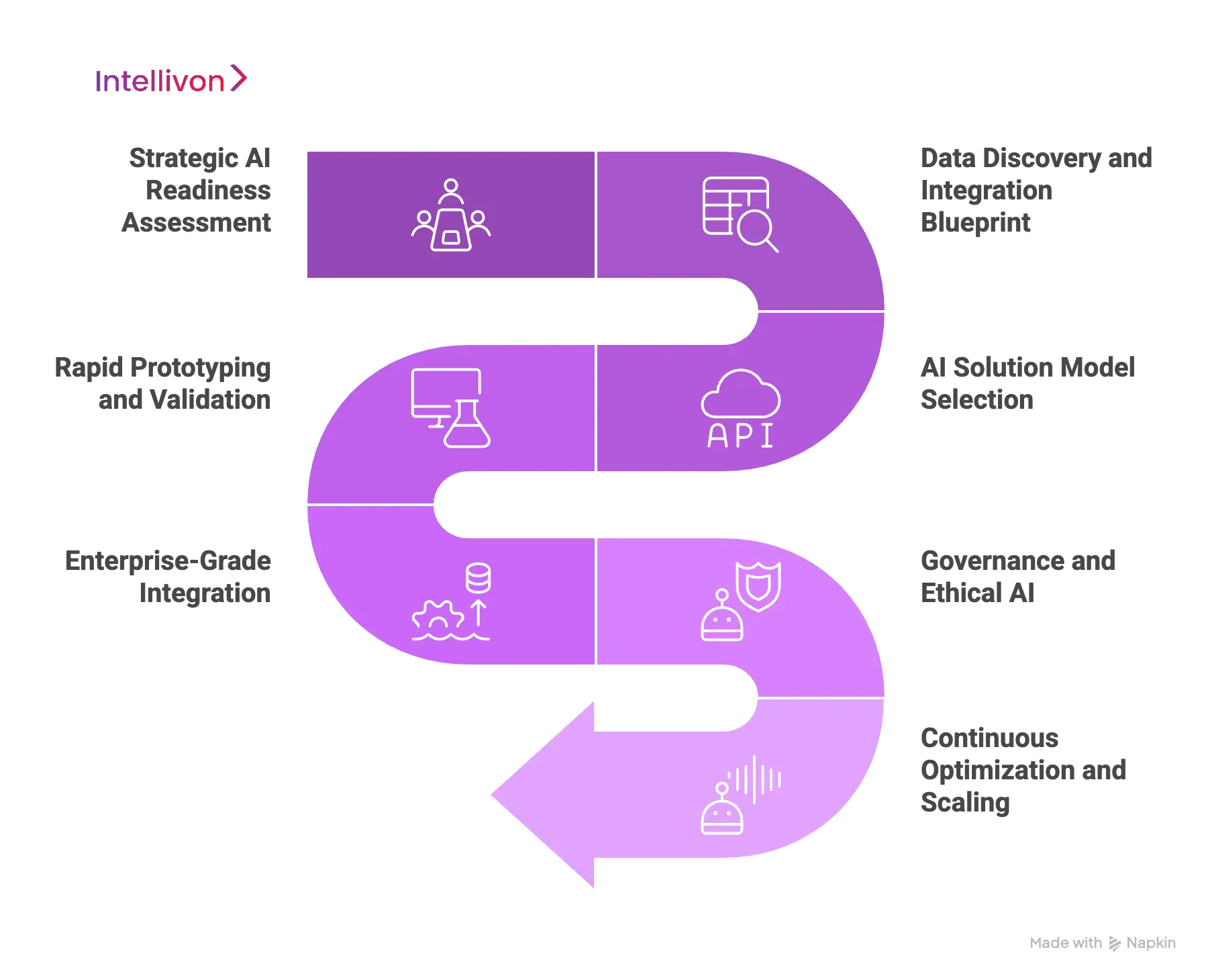
Step 1: Strategic AI Readiness Assessment
Every engagement begins with a deep strategic assessment. We work closely with leadership teams to understand your organization’s goals, operational challenges, and data maturity.
This is a targeted process to identify where AI can deliver the highest return on investment and to define the key performance indicators that will measure its success. By starting with strategy first, we ensure that AI adoption is guided by business priorities rather than technology hype, laying a foundation for solutions that have a lasting impact.
Step 2: Data Discovery and Integration Blueprint
AI’s effectiveness depends entirely on the quality and accessibility of the data it uses. Our team conducts a comprehensive audit of your data sources, from structured databases to unstructured text, images, and logs.
We assess data quality, resolve inconsistencies, and design integration pipelines that unify your information into a reliable environment. This stage transforms fragmented datasets into a cohesive asset that fuels AI accuracy and scalability. A strong data foundation means the AI models we deploy will generate insights you can trust.
Step 3: AI Solution Model Selection
With the business case clear and the data environment prepared, we move into designing the AI solution itself. Here, we map your requirements to the most effective AI capabilities, whether that’s generative AI for content creation, predictive AI for forecasting, or multimodal AI for complex decision support. In many cases, we develop custom-built models tailored to the nuances of your industry. The result is a detailed blueprint of the model architecture, features, and expected outcomes, ensuring the technology is purpose-built for your specific needs.
Step 4: Rapid Prototyping and Validation
Before committing to full-scale deployment, we create a working prototype and test it in a controlled environment within your enterprise. This stage is about proving value early, validating accuracy, confirming real-world performance, and incorporating feedback from stakeholders.
By refining the solution at this stage, we reduce risks, accelerate adoption, and ensure the AI will perform reliably when it moves into production.
Step 5: Enterprise-Grade Integration
The true power of AI emerges when it becomes part of everyday workflows. Our AI engineers integrate the solution directly into your operational systems, ERP or CRM platforms, and existing business processes.
This is done with minimal disruption, ensuring employees can work with AI naturally and effectively. Integration is about embedding AI into the rhythm of your operations so that its benefits are felt across the organization.
Step 6: Governance and Ethical AI
Trust is essential for enterprise AI adoption. We build governance and compliance frameworks into every deployment, incorporating explainability features, bias detection, and audit trails from day one.
Whether you operate in healthcare, finance, or another highly regulated sector, this step ensures that your AI systems meet industry standards, regulatory requirements, and ethical expectations. The result is a transparent and trustworthy AI solution that enhances credibility with stakeholders.
Step 7: Continuous Optimization and Scaling
AI is a living system, and its value grows when it is continuously refined and adapted. After deployment, we monitor performance, retrain models, and identify opportunities to extend AI into new use cases across the enterprise.
This ensures your AI solutions remain accurate, relevant, and aligned with your evolving business strategy. Over time, the technology scales into a comprehensive ecosystem that supports innovation and growth at every level of the organization.
This process ensures AI becomes a strategic force that delivers measurable results, strengthens decision-making, and adapts alongside your business.
Challenges Faced During AI Adoption & How We Solve Them
AI adoption in enterprises is accelerating, but success is not guaranteed. Many organizations underestimate the complexity of moving from a pilot project to a fully operational AI system. At Intellivon, we’ve seen common challenges emerge, and we’ve built targeted strategies to address them head-on.
1. Data Fragmentation and Quality Issues
One of the biggest obstacles is the state of enterprise data. Often, information is scattered across systems, stored in inconsistent formats, and riddled with inaccuracies. Without reliable data, even the most advanced AI models produce unreliable results.
Our Solution: We start every project with a data readiness program that unifies, cleans, and structures your information. This ensures that the AI models operate on a single, high-quality source of truth, improving accuracy and confidence in the results.
2. Integration with Legacy Systems
Many enterprises operate on outdated infrastructure that was never designed to work with AI. This creates compatibility issues and slows down deployment.
Our Solution: We use a modular, API-driven integration approach that allows AI solutions to work seamlessly with existing ERP, CRM, and other operational systems. This minimizes disruption and ensures adoption without forcing costly infrastructure overhauls.
3. Lack of Skilled Talent for AI Operations
AI systems require specialized skills for development, monitoring, and maintenance, a resource gap that many organizations face.
Our Solution: We provide end-to-end managed AI services, from model training to continuous optimization, reducing the reliance on in-house AI talent. Where possible, we also build user-friendly interfaces and automated pipelines so non-technical teams can work effectively with the system.
4. Ethical, Compliance, and Regulatory Risks
In regulated industries, deploying AI without clear governance can create legal and reputational risks.
Our Solution: We embed governance frameworks into every solution, incorporating explainable AI (XAI), bias detection, and audit trails. This not only ensures compliance but also builds trust with customers, partners, and regulators.
5. Unclear ROI and Business Alignment
AI projects can fail when they are driven by technology enthusiasm rather than clear business objectives.
Our Solution: We start with a measurable business case, defining the KPIs and expected outcomes before development begins. This ensures every AI initiative is tied directly to enterprise goals and delivers tangible value.
By tackling these challenges from the start, we help enterprises avoid costly missteps and turn AI adoption into a strategic advantage rather than a technical experiment.
Conclusion
In 2025, enterprises that embrace emerging AI trends position themselves to lead rather than follow. Success will come to those who adapt quickly, experiment boldly, and align technology with human needs.
These innovations are about building resilience, agility, and new possibilities. The organizations that act now will set the standard for the next decade of growth.
Transform Your Enterprise With Intellivon’s Cutting-Edge AI Solutions
With over 11 years of expertise in enterprise AI and 500+ successful custom AI deployments, Intellivon is your trusted partner for building solutions that drive measurable impact. From streamlining enterprise workflows to delivering deep, real-time insights, we help organizations transform operational challenges into competitive advantages.
Why Choose Intellivon for Your Custom AI Solution?
- Tailored AI Models for Your Industry: We design AI systems specifically for your operational needs, ensuring they’re optimized for your workflows, security requirements, and business objectives.
- Seamless Integration with Enterprise Systems: Our AI models integrate effortlessly with ERP, CRM, and legacy platforms, ensuring smooth adoption without disrupting your core operations.
- Proven ROI and Scalability: Our AI solutions are built for long-term value, reducing manual effort, accelerating decision-making, and enabling scalable growth across departments.
Want to accelerate your digital transformation with AI solutions that are scalable, secure, and business-focused? Let’s craft the right AI strategy for your enterprise.
Book a discovery call with our AI consultants today and get:
- A full audit of your enterprise AI readiness
- A tailored roadmap aligned with your strategic goals
- A detailed implementation plan with projected ROI
FAQ’s
Q1. How is AI transforming enterprise operations in 2025?
A1. AI is enabling enterprises to automate complex workflows, analyze vast datasets in real time, and make proactive, data-driven decisions. From hyper-personalized customer experiences to predictive maintenance in manufacturing, AI is now embedded across core business processes, improving efficiency, accuracy, and scalability.
Q2. Which AI trends should enterprises prioritize in 2025?
A2. The top AI trends for 2025 include agentic AI systems, AI-augmented workforce copilots, AI-driven cybersecurity, multimodal AI for unified insights, and sustainable AI practices. Enterprises should focus on trends that align with their industry needs, regulatory requirements, and long-term digital transformation goals.
Q3. What are the biggest challenges enterprises face when adopting AI?
A3. Common challenges include data integration issues, lack of in-house AI expertise, resistance to change, high implementation costs, and regulatory compliance concerns. These can be overcome with a clear AI strategy, executive buy-in, robust governance frameworks, and choosing a partner experienced in enterprise AI integration.
Q4. How can enterprises integrate AI into existing workflows without disruption?
A4. Enterprises can integrate AI smoothly by starting with pilot projects, selecting AI tools compatible with existing ERP/CRM systems, and training teams to work alongside AI. A phased rollout with measurable KPIs ensures adoption without compromising ongoing operations.
Q5. What is the ROI of implementing AI in enterprise workflows?
A5. ROI from AI adoption comes in the form of reduced operational costs, faster decision-making, increased accuracy, improved customer satisfaction, and new revenue streams. Many enterprises see returns within the first 12–18 months when AI is strategically aligned with business objectives.

